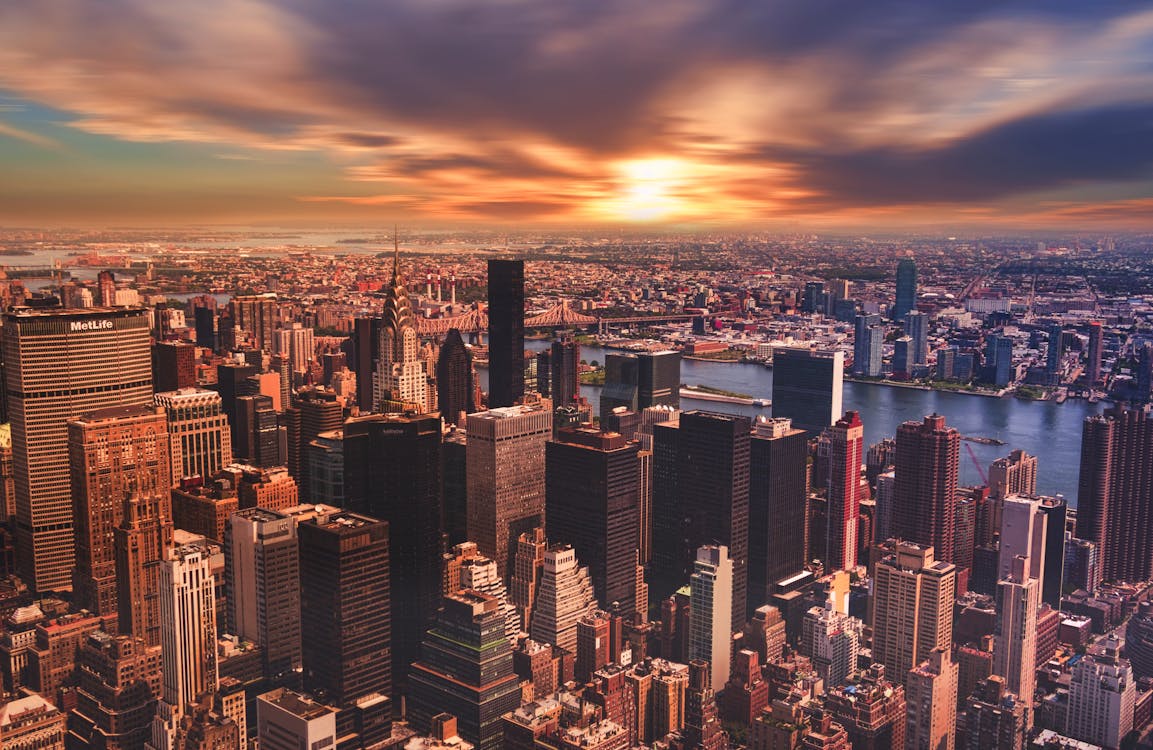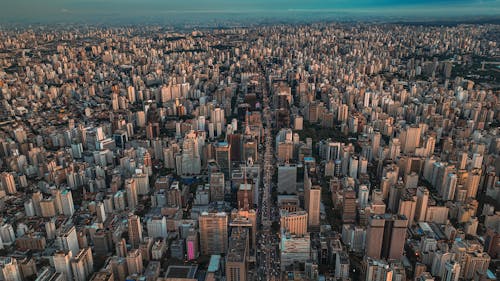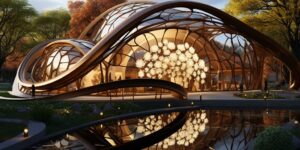Q.1) What is urbanization?

Urbanization refers to a process in which an increasing proportion of an entire population lives in cities and the suburbs of cities. Historically, it has been closely connected with industrialization. When more and more inanimate sources of energy were used to enhance human productivity (industrialization), surpluses increased in both agriculture and industry. Larger and larger proportions of a population could live in cities. Economic forces were such that cities became the ideal places to locate factories and their workers.
Amazon Prime Day 2018 | Deals Are Everywhere
Prime Day is a one-day only global shopping event exclusively for Prime members. Sign up to experience the benefits that millions of Prime Members enjoy.
Urbanization can also be explained as the expansion of a city or metropolitan area, namely the proportion of total population or area in urban localities or areas (cities and towns), or the increase of this proportion over time. It can thus represent a level of urban population relative to total population of the area, or the rate at which the urban proportion is increasing . Both can be expressed in percentage terms, the rate of change expressed as a percentage per year, decade or period between censuses .
Urban areas are usually thought to be centers of business, commerce, industry, and population. Urbanized essentially means the proportion of the population living in urban places. Early in the Unites States history urban areas were far outnumbered by rural areas. Yet, every year more and more cities are considered urban. These cities were located close to transportation routes either waterways, rails, or roads. In the 1800’s cities began to grow in importance as centers of commerce and industry due to transportation constraints. In order to participate in these opportunities you had to live in the city center otherwise you were located in the rural periphery that supplied raw materials to cities population. The opportunities presented by industrialization increased the rural to urban migration and cities began to grow.
By the middle of the 1900’s cities began to sprawl out from the center into suburbs consequently city’s population density began to decrease. People and businesses began to move out from the central city. This phenomenon was facilitated by the broadening of transportation networks including the creation of subways and more roads. In the past few decades the increase in service related industries makes distance to the city center more flexible for businesses.
The process of Urbanization

Like its product, the city- is a tumultuous phenomenon, mostly disorganized but also uniquely fascinating.
Urbanization is a result of either a push or a pull. The trend of urban migration is a universal phenomenon in all countries, but for different reasons. In some countries it is positive reasons and in some it is for negative reasons.
Positive reasons:
- attraction of the towns
- the increased efficiency of the farm, making certain amount of population free to go to the city.
These are both positive reasons, one based on the development of industry, commerce, and services in town, the other on improved agricultural techniques.
Negative reasons:
- repulsion of the rural scene
There are people in many countries that leave the rural scene because the farm standard of living is intolerable. They go to the city for negative reasons.
The main push factor causing workers to leave agriculture is the lower levels of income. The main factor determining the rate of outward movement is the expansion of employment in other occupations
Urbanization in Developing Countries
The process of urbanization has occurred differently in much of the developing world. Historically many of these countries were former colonies. They have some of the highest rates of population growth and the largest urban areas. They are characterized as being poor having significantly less technology then the developed world, and a very rapid transition from rural to urban societies. In the United State the rural to urban migration was facilitated by large-scale industrialization and the need for labor. In the developing world this is not the case. Rather, population is placing a great deal of pressure on urban areas and without having the benefit of industrialization the lack of employment opportunities for the mass of urban migrants is undermining the ability of cities to incorporate people. The consequences of this lack of employment opportunities are growing in urban areas, a large percent of whose population are unemployed and living in poverty and forced to live in unsanitary squatter settlements.
Q.2) How does urbanization effect on towns and cities?

Three types of urban impact:-
Many villages all over India are becoming increasingly subject to the impact of urban influences. The nature of urban impact, however, varies according to the kind of relations a village has with a city or town. Broadly, three different situations of urban impact may be distinguished:
- Firstly, there are villages in which a sizable number of people have sought employment in far-off cities. They leave their living behind their family members of their families in their natal villages. Upper caste migrants seem to have invested their earnings in building houses within the village. In such villages, urban employment itself often becomes a symbol of higher social prestige. Further, the city in which the emigrant is employed and the nature of his job becomes additional criteria of status-differentiation of households in the village.
- The second kind of urban impact is to be seen in villages which are situated near an industrial town. These are exposed to a different kind of influence from those with a sizable group of urban emigrants. When an industrial town like Bhilai comes up in the midst of villages, some of the villages are totally uprooted while the land of others is partially acquired. The latter are found to receive an influx of immigrant workers, which not only stimulates the demand for houses and a market inside the village but creates problems of ordering relationships between the native residents and the immigrants.
- The growth of metropolitan cities accounts for the third type of urban impact on the surrounding villages, and it is with this context of urbanization that we are presently concerned. It is normally found that, as the city expands, it sucks in the village lying in the outskirts. While a few village are totally absorbed in the process of expansion, only the land of many others, excluding the inhabited area, is used for urban development.
Besides landless villages, there are those whose land is either un-acquired or partially acquired. In such villages cultivation is still possible, but villagers may exploit such economic opportunities as market- gardening, dairy farming and poultry-keeping. They may seek employment in the city and start commuting. Another possible effect of a metropolitan city on the surrounding villages is the outflow of urban residents who wish to move out of the congested areas in the city to the open countryside.
The Urban Fringe
The area beyond the built-up suburbs may be called the urban fringe. Human ecologists and geographers describe this fringe as a transition zone between the urban and rural land uses. While some economists have paid attention to the combination of farm and non-farm occupations, and of part time farming and commuting, some sociologists have studied the emergence of new family forms. Urban fringe is related to the expanding metropolitan city. A village in the fringe today may be engulfed by the developing metropolitan tomorrow. The villages coming under the fringe have some common features.
Economic changes are more diverse in the fringe villages than in the non fringe villages, and the presence of a floating population is unique.
We have so far shown that how the impact of urban influences on the villages varies in each one of the three situations: – villages with a sizable group of urban immigrants; villages near an industrial town; and villages on a metropolitan fringe. It should, however, be noted that these situations are not mutually exclusive. While the metropolitan-fringe situation does not presuppose the industrial-urban one, the latter may be superimposed on the former. Similarly, villages in these two situations may have a sizable group of emigrants living in towns or cities, maintaining regular contacts.
Process of change might be initiated by a variety of factors such as irrigation, advancing trade and administrative frontiers, political changes, religious movements, industrialization and urbanization, or a combination of some, or all, of these.
Floating Population
It constitutes of those people who comes to the cities regularly work and than they go back to their respective towns or villages.
Social Consequences of Economic Changes
Economic changes have certain repercussions on other aspects of the traditional social structure because some areas of social life are interrelated. Also a change in one area of economic organization tends to affect another economic activity. In respect of jajmani system of service relations we have seen that while some services like those of Potters and Carpenters are no longer bound by these constraints, others like those of Blacksmiths, Sweepers and Barbers are very much part of it.
We distinguished three areas of service relationships: regular service relations arising out of the occupational role: independent of the occupational role; and customary service role. Although any two or all of these roles are performed by one or the same individual, the constraints governing each one of them are different.
Thus, while a barber ceases to shave his jajmans when he becomes a commuter, he continues to render customary service of acting as a messenger to themon ceremonial occasions. Similarly, while a blacksmith sharpens the plough shears of his jajman as part of his obligations under the jajmani system, he charges him at the prevailing market price when he sells him a sickle or a spade. The jajmani relation of the Blacksmith and Sweeper tend to be relatively unimpaired by modern economic forces.
Urban employment and occupational mobility have initiated a process of differentiation in the traditional status system based on ownership land. There are new criteria of differentiation based on income, occupation and education. Modern urban occupation has a prestige element and some are more prestigious than others.
Although some aspects of the caste system-occupational, associational and life style-have undergone changes, endogamy, rules of inter-dining and ritual hierarchy have remained relatively unimpaired.
Political Changes
However, the processes in the latter are affected by the wider social and political forces. Administrative changes and democratic political institutions have impinged upon the traditional political organization in a number of ways.
The political processes at the village level interact with those at the city level. If the rival groups among the leather workers align themselves with the opposing faction parties within the village, the latter build bridges, across the village, with the opposing political parties at the corporation level.
Increasing factional activities also minimize the chances of settlement of disputes amongst members of the dominant caste without resort to urban courts. Factional loyalty affects the very nature of the ‘moral order’ of the traditional social structure. The constraints, which govern and effect the individual actions and interpersonal relationships, become amenable to manipulation and game playing. Urban law courts are often resorted to. However, the Panchayat effectively and informally handles minor disputes among the lower castes. Although in theory the statutory Panchayat has no judicial functions, it still enjoys the prestige of the traditional village council. Both the traditional and modern legal systems are available to the people and their choice depends upon the nature of the case and expedition with which parties desire a settlement.
Image Source : https://www.pexels.com/
RECENT POSTS

Mr. Vachani’s Villa

Hotel The Zen Ladakh

Supercars in Super-Garages

Mesmerizing Pavilions: A Celebration of Fluidic Design

Indoor Landscaped Courtyards in Modern Houses

Zen Gardens for Contemporary Homes

Indo Pak Partition Memorial Complex, At Wagah (Pakistan) – Attari (India) Border: A hypothetical architectural thesis for Partition Memorial Complex

Interior Walkthrough of my Home – 4 BHK Duplex Penthouse | Modern Apartment Interior Design

Appliances & Equipment for a Modern Home of 2021


Thanks – an illuminating and interesting read. I have a professional interest in communicable disease. Spread of infection is promoted by dense populations as you describe above. The history of public health shows this. It’s tempting to consider this is a problem coming our way as urbanisation progresses. I’m curious to understand how much public health is considered during design stages.
Thank you Mr Richard Hastings!!